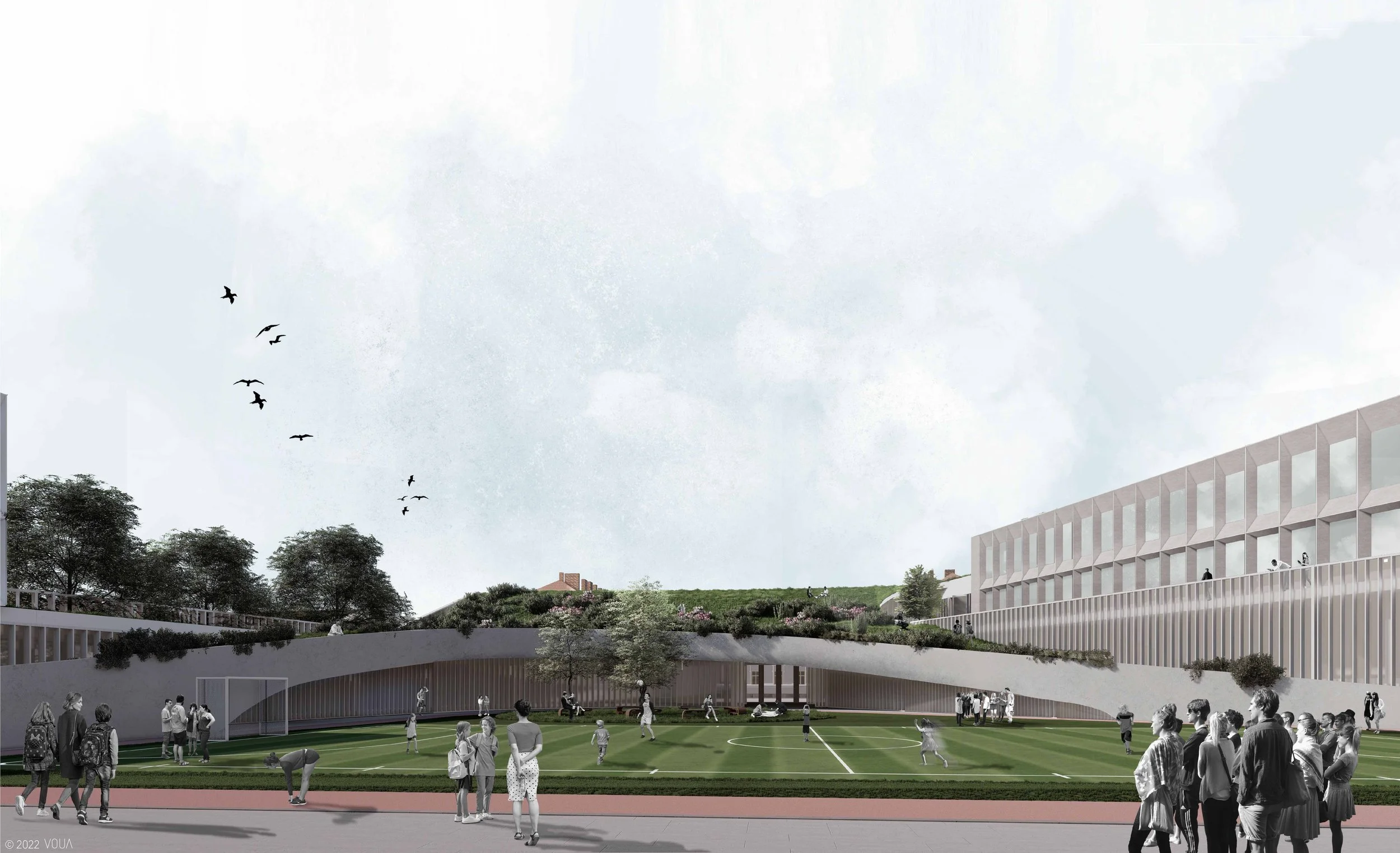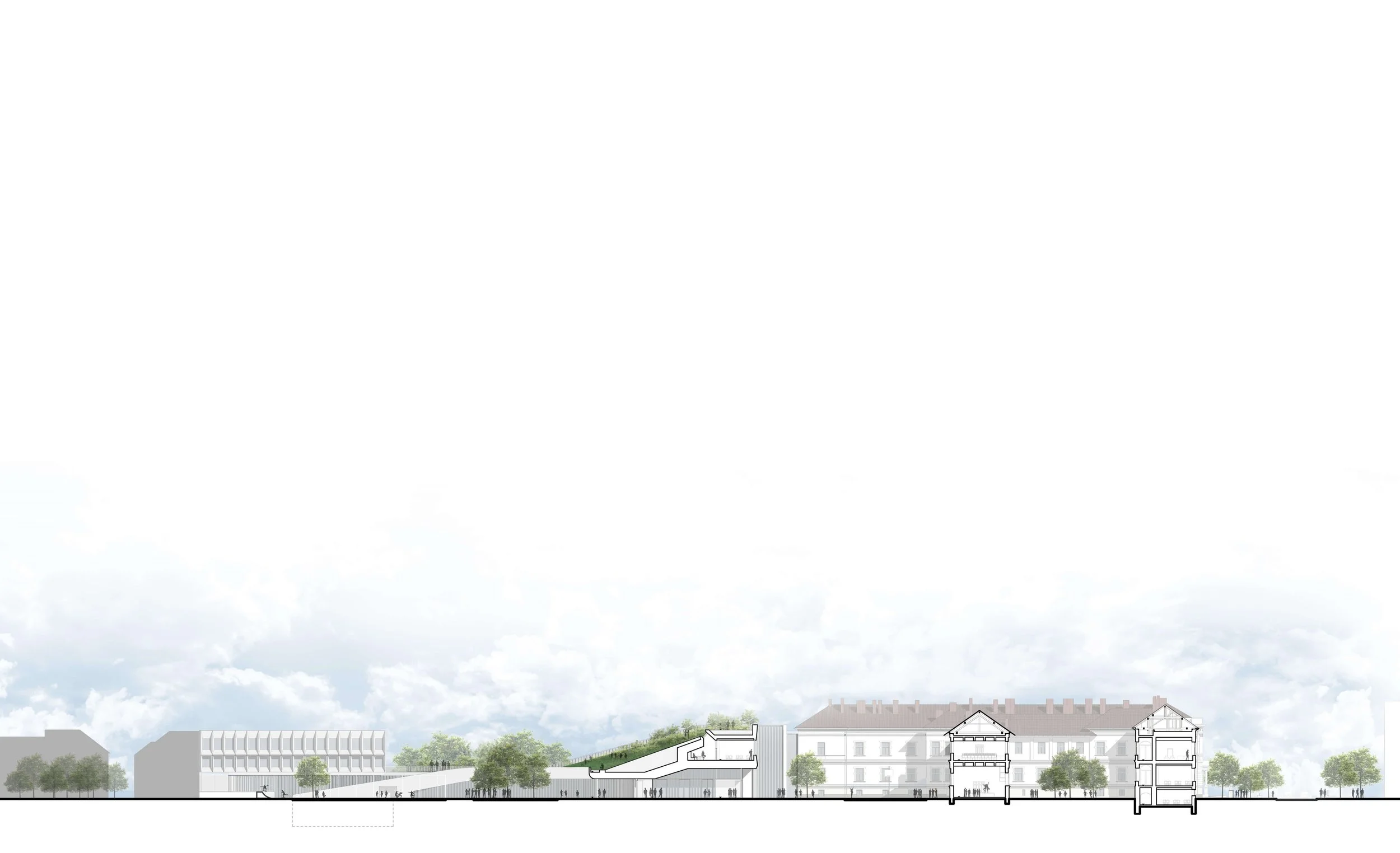-
TYPE: Competition
CATEGORY: Education - High School
LOCATION: Cluj-Napoca, România
SITE AREA: 14.800 m²
BUILT AREA: 5.530 m²
DEVELOPED AREA: 15.190 m²
CLIENT: Cluj-Napoca Municipality
-
Partners in charge: Adrian Urda, Vlad Oniga
Main authors: VOUA Arhitectură+Design - Vlad Oniga, MoD Studio - Cosmin Morărescu, Carles Tolomeiu
Coauthors: Adrian Urda, Andreea Morărescu, Rodica Luchian, Melania Bahnă, Alexandra Necula, Beatrice Grindean
-
URBAN CONCEPT
The urban concept of the design proposal revolves around the pedestrian connection between Arges and Andrei Saguna streets, and the expansion of the “walkable city” concept.
The currently car-ridden streets surrounding Balcescu School, do not offer a friendly and approachable urban space destined for children and pedestrians alike, the concept proposes a decongestion of the area by greatly reducing the traffic coming from Piata Avram Iancu, and Constanta street.
The entirety of Arges street is proposed as a mixed walkable area, with reduced vehicular access and speed, the waterway of Morii Canal is freed from the annexes suffocating it, and restored to it’s original enjoyable aspect, promoting a more pleasurable urban walking experience.
Vegetation is added along the lines of the canal, together with seating areas, bicycle stalls, nocturnal lighting and traffic restricting elements, all leading to the new main entrance to Balcescu School.
The materials used for the new Arges street are pedestrian friendly, permeable and durable, encouraging the visual and tactile continuity of the existing walkable urban spaces which have already been restructured in the historic center of the city.
Following the changes proposed for Arges street, the school is provided with a much larger and friendlier access, without the stress of excessive traffic, with a larger space for gatherings, and without the risk of children having to navigate dangerous traffic.
The urban space along the peripheral sides of the school is restructured in order to better accommodate the newly restructured Arges street, larger sidewalks are provided all around the historic building of the school, and the fence surrounding the school has been eliminated for more urban space to be created. The green areas surrounding the historic building did not offer a proper medium for children to use, so the decision was made to open this green space to the city.
SUSTAINABILITY
The refreshed urban space ensures access to vegetation, protection from sound pollution, and the cooling and ventilation benefits of the vicinity of the canal, while encouraging a more active, comfortable and relaxed lifestyle.
Arges street, in it’s newly proposed form creates a protective green barrier from the pollution of the city, while also providing an access funnel for the school, and integrating it into a more accessible urban system.
The newly proposed building is consistent with the current energy efficiency requirements, by ensuring proper insulation, high quality windows and sealed envelope, with controlled ventilation systems in order to ensure proper oxygenation and ventilation of the space with high energy efficiency.
The heating concept is a mixed system serving the existing and new building. The system mixes heat pumps and traditional gas heating, with the possibility of transitioning to a fully electric system in the future.
Main roof platforms are covered with green terraces, which capture rainwater, and dissipate it slowly, in order to not overwhelm the rain-sewage systems, and also helping with temperature control and irrigation of green terraces and outside landscaped areas. Another benefit of the green terraces is the temperature regulation.
Controlled light through a shading facade system helps with temperature regulation, and direct sunlight control, ensuring a more energy efficient cooling and heating system.
Ventilation and cooling of the building is done by using technical floors which use natural flow of air, and cool the interior air. All ventilation inside the building is controlled through powerful ventilation and filter systems.
Energy consumption is complemented by alternative energy systems like roof solar panels and photovoltaic panels, which store energy in storage batteries to be used when necessary.
STUDENTS MAIN ACCESS
Located on the southern side, on Arges street, and complementing the original historic access for the teachers on the western side, the main student access is centered along the school's facade, funneling access directly into the main inner hallway and exhibit space from the main walkable urban space.
The proposed solution for the acces is a semi-protected space, where children can spend time safe from the elements, marked by the only contrast in material present on the facade, and meant to map out the presence of the entrance.
BUILDING INTEGRATION
The proposal responds to the project brief by refreshing the entire half of eastern side of the site. All the secondary inappropriate buildings have been removed, in order to make room for a more unified and representative architectural piece.
The concept responds respectfully to the historical building, by emphasizing the facade alignment and cornice height, while also offering a generous space towards the public space.
The facades of the newly inserted volumes respond to the vicinities, through the proposed heights, the rhythm of the facades, and the general connection between volumes.
The structure of the interior courtyard is again dictated by the historical building, which already has an established courtyard towards the East. The proposed intervention creates a separation in the middle of the site, by extruding the yard upwards, generating two distinct and protected inner spaces, with different characteristics.
The first “central” courtyard, defined by the historical building, has a more official, traditional character, while the second eastern courtyard has a more dynamic one. The orientation of the extruded slope is inclined towards the Eastern courtyard, for the purpose of creating views towards sportive events, and also for expanding and connecting the main floor level to a walkable green space.
FUNCTIONALITY
From a functional perspective the newly inserted volume opens up from the main acces on the southern side, leading into a central communal space, destined for gatherings, exhibits, and general socialising.
This welcoming area is directly connected to the courtyards, and through it’s transparency it creates an open floor level. The connection between the two yards can be both open and closed according to the needs of the space, ensuring flexibility in the usage of the space.
The general organisation of the space is age-based, keeping the dedicated classes for the youngest pupils on the first floor for easiest access, and advancing in age as we advance to higher levels, while also keeping a healthy interaction between all ages in the communal spaces. The older highschool students have a dedicated space on the northern area of the new building,
Specialized laboratories are included on the first floor, ensuring easy access for all pupils. The exterior space of the new building creates a very dynamic and park-like surface, encouraging sport and a healthy active lifestyle for all the children studying at the school.
Natural light and views towards the yards for all the spaces dedicated to learning were a main focal point of the design, while also ensuring as many connections with nature and green spaces as possible.
On the southern side of the site, in direct connection to the main acces, on the first floor we have the administrative area, and right above, on the first floor the library. These spaces were intentionally designed to stand out in the space, be easily accessible and also separate from the noise of the learning spaces, in order to ensure the proper dedicated conditions.
The library storage is protected by south-facing translucent panels, permitting for light to gently enter the storage space, without exposing the books to direct sun. The studying area of the library is oriented towards the northern facade, for gentle indirect reading light.
The library is easily accessible from the main floor, and from it’s main level it has a direct connection to the green platform and terrace garden leading to the outside space. This connection can ensure relaxed studying spaces in nature, while also encouraging pupils to visit the library from multiple sides. These spaces can also be used for outdoor classes.
SOCIAL CONCEPT
The children's social environment being at its most important in childhood, is the drive behind the functionality of the space. This concept unfolds in the connective space of the proposal, both at an urban level and a functional one. The outdoor and indoor spaces intertwine and intersect attracting movement and interaction between users.
All design elements were taken into account and constructed around encouraging creativity, stimulating the body and the mind of students, by ensuring a contemporary learning space,
The interior spaces provide alcoves for quality socialising and interactions both doring classes and on breaks, in different size groups and activities, ensuring a healthy social development for children.
RESTORATION RECOMMENDATIONS OF THE HISTORIC BUILDING
The principles of the interventions proposed for the historic building comprise:
UNDERGROUND and BUILDING BASE interventions:
- Foundation consolidation and repairs
- sanitation of the water damaged underground and building base, by eliminating damaged finishes, drying and refinishing with reparation and sanitation finishes.
- elimination of the peripheral concrete and asphalt on the side of the building, and replacing it with permeable finishes.
- structurally consolidating the foundations of the historic building where necessary for the intervention.
- inserting new water insulations, and injections where necessary, in order to eliminate underground water infiltrations
- creating a peripheral water drainage system surrounding the entire historic building
- ensuring proper ventilation of the existing building, for proper elimination of humidity.
- underground levels must have ensured peripheral permeable flooring.
- for salt damage, after proper humidity treatment, elimination / reconstruction / cleaning of damaged elements will be ensured before refinishing with permeable historic finishes.
- inserting water insulating material for stopping water ascension;
ROOF INTERVENTIONS
- Proper reparations to the roof will comprise of replacing damaged wooden elements;
- Cleaning of debris, and obstructing bird acces
- Water barrier and Insulation for ensuring proper energy efficiency, could be added in the future either on floor level, or on the roof level, in order to create extra spaces in the attic;
Fixing all gutters, drains and water capture elements, and ensuring safe proper elimination of the water away from the building.
Previous
Previous
Lucian Blaga High School
Next
Next




















